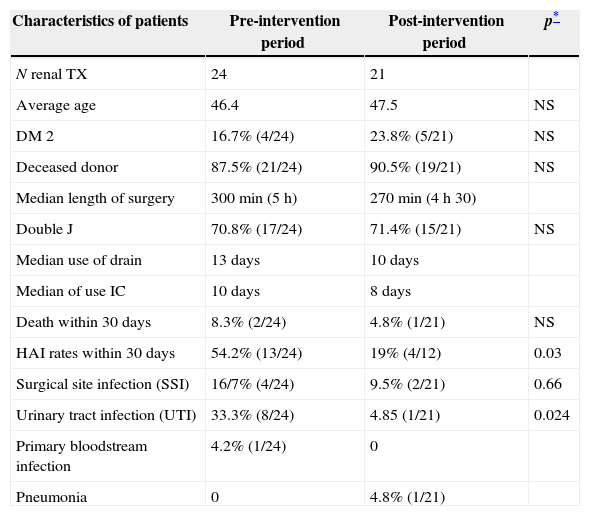At our institution, we observed an increase in the incidence of healthcare-associated infections (HAI) due to Gram-negative bacilli, including three cases of carbapenem-resistant Klebsiella pneumoniae, among patients who underwent renal transplantation. In addition to strengthening infection control measures, we chose to add gentamycin to the antibiotic prophylaxis regimen of patients undergoing renal transplantation. We assessed the number of HAI occurring within 30 days of renal transplantation during two time periods: (1) the pre-intervention period, between September 2009 and June 2010, and (2) the post-intervention period, between July 2010 and April 2011. The intervention consisted of the addition of gentamycin to the surgical antibiotic prophylaxis regimen. The percentage of patients with HAIs was 31% lower during the post-intervention period (p=0.03), with the greatest reductions observed for urinary tract infections (p=0.024). Carbapenem-resistant K. pneumoniae was not isolated during this period. The investigated patients did not exhibit worsening renal function. Further studies are needed to assess antibiotic prophylaxis in renal transplantation patients at institutions where there is a high prevalence of multidrug-resistant Gram-negative bacteria.
The optimal perioperative antibiotic prophylaxis regimen for renal transplant patients remains to be determined, and prophylaxis should be administered based exclusively on clinical evidence.1,2
At our institution, the Infection Control team observed an increase in the incidence of healthcare-associated infections (HAI) due to Gram-negative bacilli, including three cases of carbapenem-resistant Klebsiella pneumoniae, among patients who underwent renal transplantation,3,4 and measures were proposed to reduce the incidence of HAI.
The Instituto Dante Pazzanese de Cardiologia, located in São Paulo, is a public university hospital with a capacity of 350 beds for cardiovascular surgeries. Approximately 40 renal transplantation surgeries are performed annually. The Institution has a hospital infection control and prevention program and performs active disease surveillance, following criteria from the Centers for Disease Control and Prevention (CDC).5
We assessed the number of HAI occurring within 30 days of renal transplantation during two time periods: (1) the pre-intervention period, between September 2009 and June 2010, and (2) the post-intervention period, between July 2010 and April 2011.
The intervention consisted of an addition of gentamycin to the surgical antibiotic prophylaxis regimen. This addition was based on the previously determined sensitivity profile of HAI-causing bacteria. Antibiotic prophylaxis was administered during the post-intervention period. This regimen included two doses of gentamycin 2mg/kg, one at the start of anesthesia and one 24h later; one dose of cefuroxime 1.5g at the start of anesthesia; and 750mg of cefuroxime every 12h for the next 48h. Cefuroxime had been previously used at our institution.
The characteristics of the patients during the pre- and post-intervention periods are presented in Table 1.
Clinical characteristics of the patients during the pre- and post intervention periods.
| Characteristics of patients | Pre-intervention period | Post-intervention period | p* |
|---|---|---|---|
| N renal TX | 24 | 21 | |
| Average age | 46.4 | 47.5 | NS |
| DM 2 | 16.7% (4/24) | 23.8% (5/21) | NS |
| Deceased donor | 87.5% (21/24) | 90.5% (19/21) | NS |
| Median length of surgery | 300min (5h) | 270min (4h 30) | |
| Double J | 70.8% (17/24) | 71.4% (15/21) | NS |
| Median use of drain | 13 days | 10 days | |
| Median of use IC | 10 days | 8 days | |
| Death within 30 days | 8.3% (2/24) | 4.8% (1/21) | NS |
| HAI rates within 30 days | 54.2% (13/24) | 19% (4/12) | 0.03 |
| Surgical site infection (SSI) | 16/7% (4/24) | 9.5% (2/21) | 0.66 |
| Urinary tract infection (UTI) | 33.3% (8/24) | 4.85 (1/21) | 0.024 |
| Primary bloodstream infection | 4.2% (1/24) | 0 | |
| Pneumonia | 0 | 4.8% (1/21) |
The microorganisms isolated during the pre-intervention period were, 4 Enterobacter spp., 4 Escherichia coli, 1 Proteus mirabilis, 1 multi-sensitive K. pneumoniae and 3 carbapenem-resistant K. pneumonia. In the post-intervention period 1 Enterobacter cloacae, 1 E. coli and 1 multi-sensitive K. pneumoniae were isolated.
The percentage of patients with HAIs was 31% lower during the post-intervention period (p=0.03), with the greatest reductions observed for urinary tract infections (p=0.024). Carbapenem-resistant K. pneumoniae was not isolated during this period.
The investigated patients did not exhibit worsening renal function.
The optimal regimen for perioperative antibiotic prophylaxis after renal transplantation remains to be determined. At our institution, we observed an increase in HAI in renal transplantation patients and, in addition to strengthening infection control measures we were encouraged to add gentamycin to the antibiotic prophylaxis regimen of patients undergoing renal transplantation. In the post-intervention period a significant reduction in HAI was observed (p=0.03), with the greatest reductions observed for urinary tract infections (p=0.024).
Based on these findings, gentamycin was included in the institutional protocol for surgical antibiotic prophylaxis for renal transplantation.
A limitation of this study is that only one public hospital in São Paulo was evaluated, such that the sample may not represent the general Brazilian population.
Further studies are needed to assess antibiotic prophylaxis in renal transplantation patients. These studies should include a larger number of patients and should be conducted at institutions where there is a high prevalence of multidrug-resistant Gram-negative bacteria.
Conflict of interestAll authors declare to have no conflict of interest.
We acknowledge Celia F. Haroguchi’ contribution in execution of several steps in this study.





